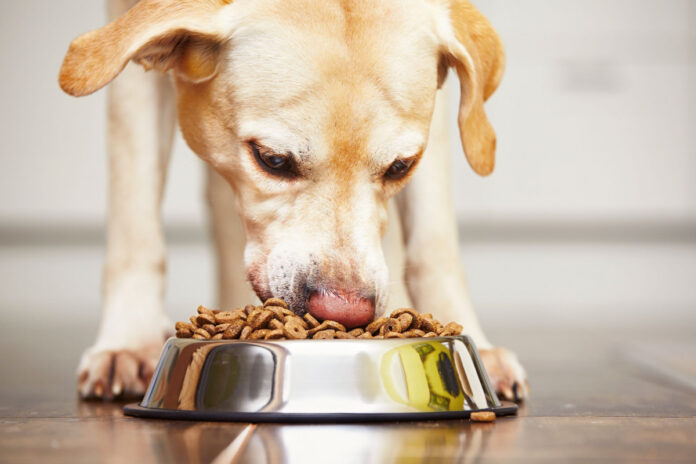If you feed your dog kibble and you’re wondering if you can also add raw food to their diet, here’s some information that will help you make an informed decision. First, we need to be clear about what raw food consists of (and doesn’t consist of). Raw food contains all the nutrients that dogs need to thrive, but it doesn’t contain preservatives or other unnecessary additives that are commonly found in kibble.
The basics
With more pet owners ditching dog kibble in favour of raw food diets, many have been asking can I feed my dog raw food and kibble?. It’s not easy to make sure your pup is eating right, especially if you’re working all day. We asked our experts whether it’s possible to combine a raw diet with store-bought food. We’ve got plenty of dog nutrition advice, so before we jump into what we think about feeding raw and kibble together, let’s talk about why some people choose to do it.
The idea behind raw feeding is that dogs are carnivores, so they should eat meat like their wild ancestors did. Proponents believe that cooking or processing food destroys nutrients that dogs need for optimal health. They also point out that cooking destroys some bacteria and parasites (the ones that aren’t killed by freezing).
Those who support combining a raw diet with commercial foods say convenience is key for them—and their dogs. It’s much easier to buy a bag of dog food than it is to prepare homemade meals every day. Some people also choose to feed kibble and raw because they believe it helps dogs get all of their nutritional needs met without getting too many calories from fat or protein, which can lead to obesity and other health problems.
How old is your dog?
While it’s not generally recommended to feed a dog raw food and kibble simultaneously, you can certainly make them both a part of your dog’s daily diet. If your dog is older than one year, then you have an increased risk of his immune system being compromised. Dogs don’t have fully formed immune systems until about one year old.
This means if your dog has gotten older without ever eating raw food or kibble at any point in his life, his immune system is likely less effective at combating disease and infection than it would be if he’d had regular exposure to these types of foods from a young age.
Don’t get it mixed up with pet food
While it’s true that dogs and cats are capable of eating a raw food diet, they’re not necessarily meant to. Many dog owners feed their furry friends a raw food diet, believing that doing so will provide all of their pet’s necessary nutrients. Dogs are omnivores (like humans), meaning they can eat a variety of foods, including meat and grains—but not all dogs can tolerate large amounts of grains in their diets.
If you do plan on mixing raw food with kibble, try to make sure your dog has his complete nutrition from both sources; don’t rely on one as your only option! Dogs have different nutritional needs based on their size, age, life stage and activity level—not to mention unique sensitivities or allergies.
What about allergies?
Some dogs have allergies to raw food, although it’s not common. If your dog does have an allergy, ask your vet about hydrolyzed protein dog food or a hypoallergenic diet that is free of grains and soy. Because these foods require special processing, they’re more expensive than regular dry kibble. However, suppose you’re struggling with allergies in your dog (and yourself). In that case, it may be worth your while to try a hypoallergenic diet or hydrolyzed protein pet food—even if it’s just temporarily until you’ve got things under control.
No vet visits required?
Dogs are, at a minimum, omnivores. So yes, you can feed your dog raw food and kibble. Like all animals, dogs need a balanced diet for optimum health. If you’re feeding your dog kibble without other supplements or are feeding them human-grade raw meat from questionable sources, there may be some risk to your pet’s health.
As with humans, healthy eating is about striking a balance between nutrition and calories. Your dog should get about 30 percent of its calories from protein (this number varies based on your pet’s lifestyle) and between 15 percent and 20 percent of its calories from fat. The rest of your dog’s calories should come from carbohydrates.
The Association of American Feed Control Officials recommends that adult dogs eat between two and three cups of dry food per day, which translates to 1,500 to 2,000 calories. That said, many experts recommend that owners adjust their pets’ diets based on activity level and weight goals rather than relying strictly on calorie counts; if you have questions about how much food is right for your pup, talk to your vet!
Get support from other owners
A great way to get support for your decision is to get involved with an online community. You can share stories, ask questions and connect with other pet owners who have adopted a raw diet or are thinking about doing so. The most prominent communities are run by companies such as Blue Buffalo, Wellness and Merrick.
There are others, though, so do a search if you’d prefer another resource. Make sure that whatever site you choose has strict guidelines against members selling products or promoting brands to avoid any conflict of interest regarding advice. Be wary of too much specific advice as well; what works for one dog may not work for yours.
Stick to meat, fruits, and vegetables
You can feed your dog raw meat, fruit, and vegetables. Avoid processed food, which may contain additives or byproducts. You can easily switch to a raw food diet if you already feed kibble or canned food once or twice a day. Plan on adding a third meal of raw chicken wings, ground beef with bone marrow or boneless chicken breast cut into pieces, perhaps seasoned with cinnamon and apple cider vinegar. (Don’t worry your dog won’t get cavities!) You might also want to consider adding supplements in addition to your dog’s diet as well; look for vitamins that are specifically formulated for dogs.
Remember: For safety reasons, make sure that every ingredient in each meal is cooked thoroughly before serving it to your pet.
Caring for your raw dog’s teeth & coat
Chewing on raw bones is fantastic for your dog’s teeth and gums, but it can also lead to dental disease if you don’t brush their teeth. The bacteria in raw meat and bones is dangerous to humans if ingested but isn’t harmful to dogs. However, all that chomping can lead to plaque buildup in your dog’s mouth. Brushing your dog’s teeth not only prevents plaque buildup but can improve their breath and reduce bad bacteria that lead to diseases like gum disease or even heart disease and other serious illnesses. If you are concerned about accidentally swallowing some of your pet’s food while grooming them, consider a doggie toothbrush!
Conclusion
There are many pros and cons to feeding a dog kibble, as there are to feeding raw food. Ultimately, you have to decide what’s best for your dog, and that may change over time. If your dog has been eating kibble his whole life, he may be healthier than if he ate nothing but raw food. If your current feed routine isn’t doing him any favours, however, or if you’re starting from scratch, there are several good options out there for mealtime. Just be sure to check with your vet before making any significant changes!


